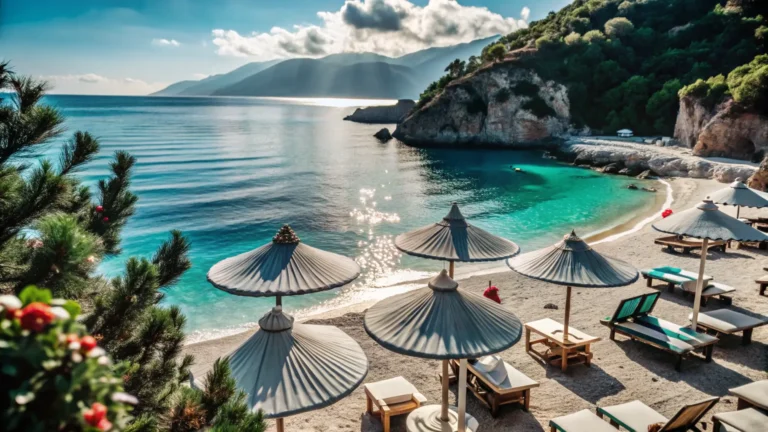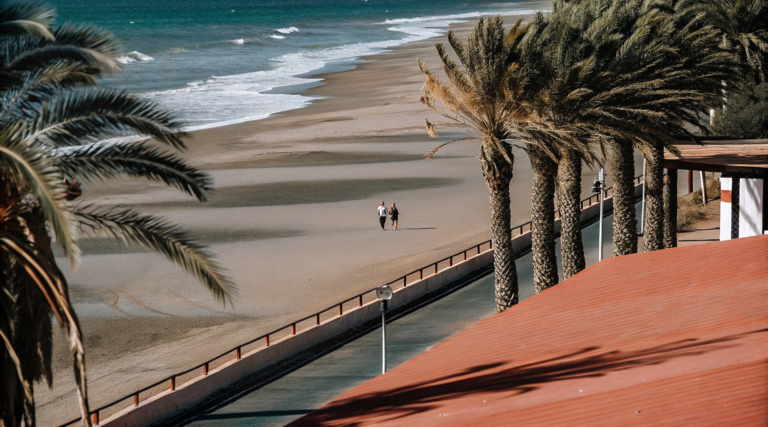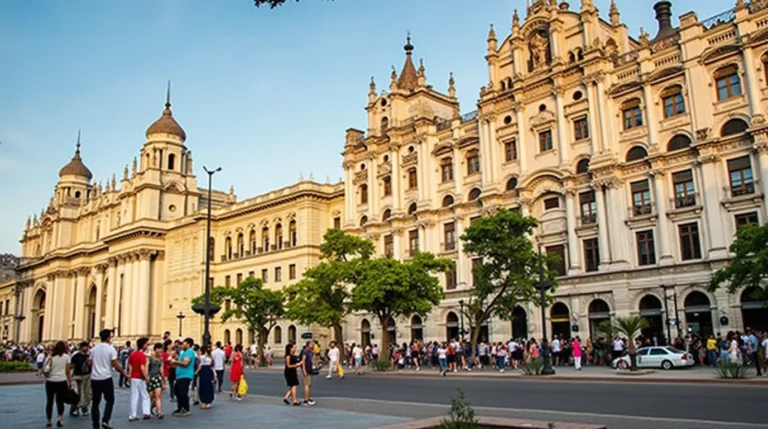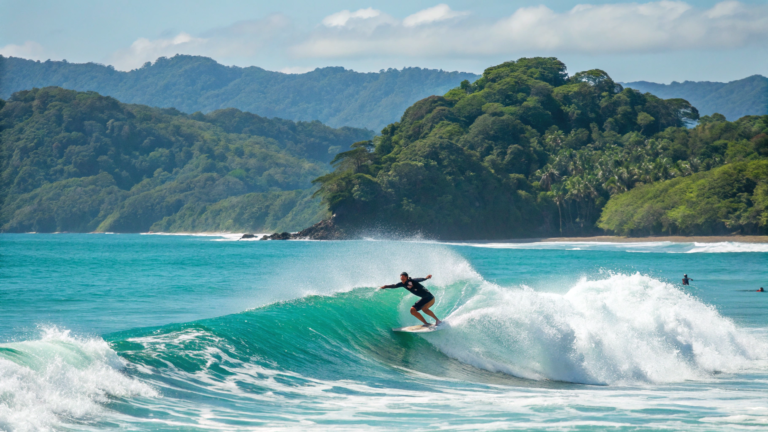Landmarks in Cuba 6 Epic Destinations You’re Insane to Skip
Thinking back on my travels, I remember José Martí’s words, “The landscape of a country is its greatest poem.” These words echo in my mind as I look at Cuba’s 3 human made landmarks. Places like El Capitolio and the beautiful Plaza de la Revolución show Cuba’s rich history and stunning architecture.
Cuba is a goldmine of landmarks and historical sites, with nine UNESCO World Heritage Sites. It’s a mix of Spanish, African, and indigenous cultures. You’ll find amazing places to visit, like the 3 human made landmarks in Cuba. I’m excited to share these with you.
Table of Contents
My Journey Through Cuba’s Architectural Wonders
Walking through Cuba’s streets, I fell in love with its iconic buildings. They mix old charm with new style perfectly. Each building tells a story of Cuba’s history and culture.
The Capitolio and the Cathedral of Havana show Cuba’s past and fight for freedom. These monuments are key to understanding the country.
Cuban architecture is special because it makes you feel nostalgic and amazed. The bright colors, detailed balconies, and intricate designs are stunning. In Havana’s historic center, I saw buildings that amazed me with their size and beauty.
The best time to see these wonders is from November to April. The weather is nice, and there are fewer people around.
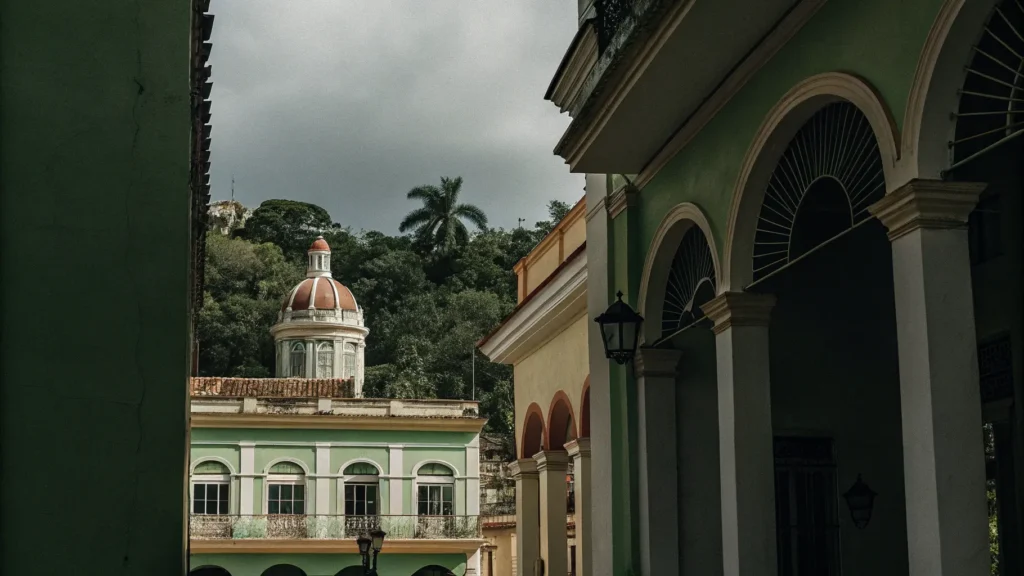

Why These Landmarks Matter
These landmarks are more than just buildings. They show Cuba’s history and culture. They tell us about the country’s struggles and victories.
By visiting, we learn about Cuba’s past and its people. We see the beauty and importance of its architecture.
What Makes Cuban Architecture Unique
Cuban architecture combines colonial, Art Deco, and modern styles. This mix shows Cuba’s history and cultural influences. The bright colors, detailed balconies, and designs make it stand out.
The Capitolio and the Cathedral of Havana are examples of Cuba’s rich heritage. They show the country’s fight for freedom.
| Landmark | Location | Historical Significance |
|---|---|---|
| Capitolio | Havana | Symbol of Cuban independence |
| Cathedral of Havana | Havana | Colonial masterpiece and religious significance |
| Plaza de la Revolución | Havana | Symbol of Cuban identity and revolution |
The 3 Human Made Landmarks in Cuba You Can’t Miss
Exploring Cuba’s vibrant streets, I find myself drawn to its rich history and stunning architecture. Among the many cuba tourist attractions, three landmarks stand out. They are a must-see for anyone visiting the island.
El Capitolio’s grandeur and the Cathedral of Havana’s historic value are unforgettable. Plaza de la Revolución, with its iconic Che Guevara mural, shows Cuba’s revolutionary spirit. These landmarks reflect Cuba’s past and celebrate its culture and resilience.
Some of the key features of these landmarks include:
- El Capitolio’s stunning architecture and recent renovations
- The Cathedral of Havana’s historic significance and beautiful design
- Plaza de la Revolución’s iconic mural and role in Cuban history
Exploring these landmarks’ history and significance reminds me of the importance of preserving our cultural heritage. Whether you’re into history, architecture, or culture, these landmarks will impress you. With their mix of history, culture, and natural beauty, cuba tourist attractions like these are a must-see. The top landmarks in cuba showcase the country’s rich history and its people’s resilience.
El Capitolio: Havana’s Crown Jewel
Walking through Havana, El Capitolio’s grandeur catches my eye. This building is a masterpiece of Cuban architecture. Its dome and details are stunning. It’s a top spot for those who love Cuban architecture.
El Capitolio’s history is as captivating as its design. Built in the early 20th century, it was the heart of Cuba’s government. Now, it welcomes tourists from everywhere.
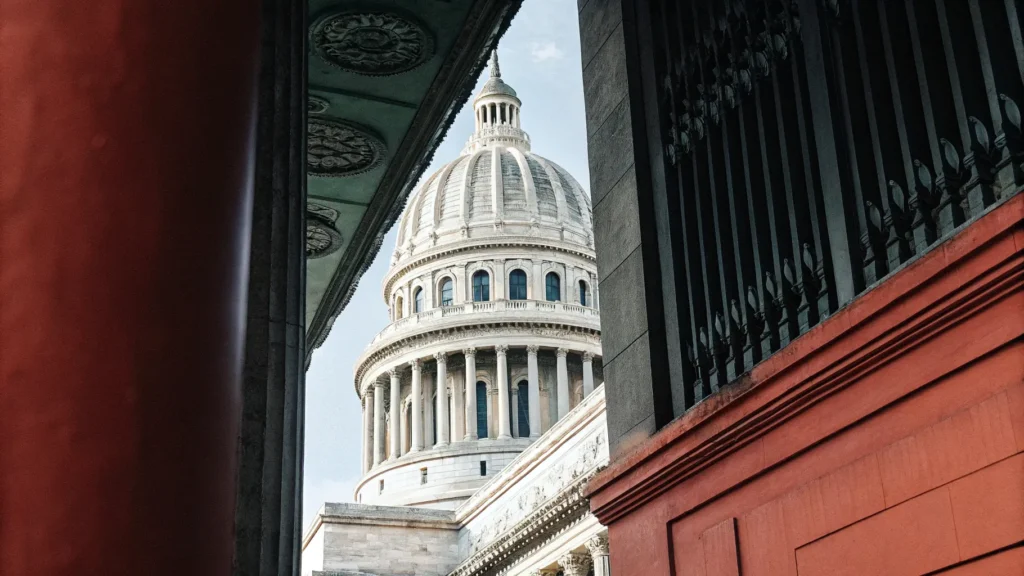

Architectural Features
The dome of El Capitolio reminds me of the US Capitol. Its facade is full of sculptures and decorations. Inside, the grand hall and staircase are breathtaking.
Historical Significance
El Capitolio has seen many key moments in Cuban history. It played a role in the fight for independence and the revolution. Today, it stands as a symbol of Cuban pride.
Visitor Experience
Visitors can explore El Capitolio on a guided tour. They see the grand hall, staircase, and dome. The tour offers a deep dive into the building’s history and architecture. El Capitolio is a must-see for anyone interested in Cuban landmarks and architecture.
Plaza de la Revolución: Symbol of Cuban Identity
Exploring cuba’s iconic buildings, the Plaza de la Revolución stands out. It’s a large square with deep political meaning in Cuba. The square is where important landmarks like the José Martí Memorial are found. It’s where Cuba celebrates big, hosting events and speeches.
The José Martí Memorial dominates the plaza. Must-see cuban structures like the image of Che Guevara add to its revolutionary feel. The plaza is huge, making it a key spot for gatherings and demonstrations in Havana. It marks Cuba’s journey after the revolution, showing its identity and cultural heritage.
Some key features of the Plaza de la Revolución include:
- A vast square with significant political importance
- Home to the José Martí Memorial and other important landmarks
- Host to major national celebrations and events
- Features iconic images of Che Guevara and other revolutionary figures
The Plaza de la Revolución is a must-see cuban structure. It’s a center of politics and culture, showing Cuba’s rich history and heritage. Its importance goes beyond its looks, symbolizing Cuba’s fight for freedom and self-determination.


Cathedral of Havana: Colonial Masterpiece
Walking through Havana, the Cathedral of Havana caught my eye. It’s a colonial architecture gem. This landmark is key among historical monuments in Cuba. It’s not just beautiful; it’s also deeply rooted in Cuba’s culture and faith.
The Cathedral of Havana is a standout among Cuba tourist attractions. Its stone carvings and details are breathtaking. Inside, you’ll see Baroque and Neoclassical styles. The stained-glass windows and altar are truly stunning.
Religious Significance
The Cathedral of Havana holds a special place in the hearts of many. It’s a symbol of Havana’s rich culture. People from all over come to see its beauty and learn its history.
Architectural Elements
The cathedral’s design is a feast for the eyes. Its stone carvings and details are incredible. The exterior, with its mix of styles, towers, and domes, is a sight to behold.
Photography Tips
For the best photos, visit early morning or late afternoon. The light is soft and golden. Use a wide-angle lens to capture the cathedral’s grandeur and surroundings.
Seven Historical Sites That Tell Cuba’s Story
Cuba is filled with historical sites that share its complex and fascinating history. Exploring these landmarks is a must for visitors. From Old Havana’s colorful streets to Morro Castle’s historic fortifications, each site has its own story.
Some key landmarks include Old Havana, Castillo de la Real Fuerza, and Morro Castle. These places highlight Cuba’s rich culture and history. They feature stunning architecture and hold significant historical value.
Exploring Cuba’s Historical Sites
To understand Cuba’s history, visitors should check out these sites:
- Old Havana: a UNESCO World Heritage site with its winding streets, parks, and colonial buildings
- Castillo de la Real Fuerza: a historic fort that shows Cuba’s military past
- Morro Castle: a beautiful example of Spanish colonial architecture
These landmarks offer a peek into Cuba’s history, from the colonial era to today. By visiting these sites, travelers can learn more about Cuba’s culture and history.
| Site | Location | Historical Significance |
|---|---|---|
| Old Havana | Havana | UNESCO World Heritage site, colonial architecture |
| Castillo de la Real Fuerza | Havana | Historic fortification, military past |
| Morro Castle | Havana | Spanish colonial architecture, stunning views |
Getting Around These Cuban Landmarks
Exploring Cuba’s vibrant cities was an exciting journey. I found that getting around cuba tourist attractions is fun. With over 900 historical sites in Havana’s old quarter, planning your transport is key. The local bus system or renting a classic car are great ways to see the city.
For cuba landmarks for visitors, mix walking and taxis. The Capitolio and Cathedral of Havana are easy to walk to. Also, the tourist hop-on hop-off bus offers a city tour.
Here are some tips for getting around Cuba:
- Use the local bus system to get around Havana and other cities
- Rent a classic car to drive around the city and explore the surrounding countryside
- Take a taxi to get to specific landmarks or destinations
- Walk around the old quarter to discover hidden gems and historic sites
By following these tips, you’ll easily navigate Cuba’s streets. You’ll enjoy your visit to these amazing cuba tourist attractions and cuba landmarks for visitors.
| Transportation Option | Cost | Duration |
|---|---|---|
| Local Bus | $1-2 | 30 minutes – 1 hour |
| Taxi | $10-20 | 15-30 minutes |
| Classic Car Rental | $50-100 per day | Varies |
Best Photography Spots at Cuban Landmarks
Cuba is a dream for photographers, with its famous Cuban landmarks and architectural wonders in Cuba. It offers a mix of history, culture, and natural beauty.
Every spot has its own best time for photos. The National Capitol Building, El Capitolio, and the Cathedral of Havana are famous for their beauty.
Morning Light Locations
The morning light in Cuba is perfect for capturing colors and textures. Some top spots for morning photos are:
- Old Havana, with its narrow streets and historic buildings
- Viñales Valley, with its stunning natural scenery and tobacco plantations
- Trinidad, with its well-preserved colonial architecture
Sunset Shooting Spots
The sunset in Cuba is breathtaking, with warm light on the architectural wonders in Cuba. Some great sunset spots are:
- The Malecón, with its stunning views of the sea
- La Cabaña Fortress, with its historic significance and picturesque surroundings
- San Pedro de la Roca Castle, with its breathtaking views of the bay
| Location | Best Time | Photography Tips |
|---|---|---|
| Old Havana | Morning | Capture the vibrant colors and textures of the historic buildings |
| Viñales Valley | Morning | Focus on the stunning natural scenery and tobacco plantations |
| La Cabaña Fortress | Sunset | Capture the historic significance and picturesque surroundings |
Conservation Efforts and Current Status
Reflecting on my journey through Cuba’s iconic buildings, I see the need for conservation. The Cuban government works hard to protect these structures. They focus on restoring historic buildings and preserving natural habitats.
Efforts like restoring the Reina Cemetery in Cienfuegos and the Jewish Cemetery in Guanabacoa show their dedication. They also protect national parks, like the Desembarco del Granma National Park. This helps keep Cuba’s unique plants and animals safe.
Restoration Projects
Many restoration projects are underway in Cuba. For example, the Ingenio Carolina sugar plantation and factory from 1835 is being restored. These efforts not only save Cuba’s history but also create jobs and attract tourists.
Future Preservation Plans
Looking ahead, Cuba plans to keep its buildings and nature safe. They’ve set priorities like Agro-Industrial Heritage, Wooden Architecture, and Urban Industrial Heritage. This way, Cuba’s beauty and history will be enjoyed by future generations.
Tips for Making the Most of Your Visit
Exploring Cuba’s vibrant cities and stunning cuba tourist attractions requires preparation and planning. With its 3,570-mile coastline along the Caribbean Sea, Cuba offers a wide range of experiences. From historic landmarks to beautiful beaches, there’s something for everyone.
Make sure to spend at least 90 minutes at the National Museum of Fine Arts (Museo de Bellas Artes). Also, visit the top landmarks in cuba like El Capitolio and the Cathedral of Havana. Don’t forget to walk along the Malecón in Havana during sunset for amazing photos.
Some must-see places include:
- Old Havana, a UNESCO World Heritage Site
- Viñales Valley, known for its distinctive limestone hills and lush tobacco fields
- Trinidad, a charming town perfect for strolling on foot
Plan your visit according to the opening hours of the attractions. For example, the Museo Nacional de Bellas Artes is open Tuesday through Sunday with varying hours. Cuba’s rich culture and stunning landscapes make it a perfect vacation spot.
Embracing Cuba’s Architectural Heritage
Cuba is a treasure trove of architectural wonders. From the captivating historical monuments in cuba in Havana to the picturesque cuba landmarks for visitors in the countryside, Cuba’s built heritage is a testament to its rich cultural identity.
Our journey showed us the intricate details and captivating stories of these landmarks. Sites like El Capitolio, Plaza de la Revolución, and the Cathedral of Havana each play a unique role in Cuba’s history. Exploring these architectural gems gives us a deeper appreciation for Cuba’s past and present.
As we say goodbye to these remarkable historical monuments in cuba, I’m filled with wonder and a desire to explore more. Cuba has truly captured my heart. I encourage all travelers to dive into its architectural splendor and embrace the rich cultural heritage found throughout this remarkable destination.
FAQ
What are the 3 human-made landmarks in Cuba that I shouldn’t miss?
You must see El Capitolio, Plaza de la Revolución, and the Cathedral of Havana. Each landmark gives a unique view of Cuba’s rich history and culture.
What makes Cuban architecture so unique?
Cuban architecture mixes Spanish, African, and indigenous styles. This creates a unique and captivating style. From El Capitolio’s grand domes to Old Havana’s colonial streets, it’s full of fascinating details.
When is the best time to visit these Cuban landmarks?
The best time to visit Cuba depends on what you like. The dry season (November to April) has better weather and fewer crowds. The rainy season (May to October) is less crowded and offers a more authentic experience.
What makes El Capitolio so iconic?
El Capitolio in Havana is famous for its stunning architecture and history. Its impressive dome and detailed design make it a masterpiece of Cuban architecture. It’s a must-see for anyone interested in Cuba’s culture.
Why is Plaza de la Revolución a symbol of Cuban identity?
Plaza de la Revolución is a vibrant landmark in Havana. It’s a center of political and cultural activity. Its architecture and history make it a symbol of Cuban identity, showing the country’s revolutionary spirit.
What makes the Cathedral of Havana a masterpiece of colonial architecture?
The Cathedral of Havana is a stunning example of colonial architecture. Its stone carvings and details are breathtaking. It’s a key site for exploring Cuba’s cultural heritage.
What are some of the key historical sites in Cuba that tell the country’s story?
Key sites include Old Havana, Castillo de la Real Fuerza, and Morro Castle. Each site offers a unique look into Cuba’s history, from its colonial past to its revolutionary present.
What are some tips for getting around and exploring Cuba’s landmarks?
You can explore Cuba’s landmarks by walking, taking taxis, or using public transport. Plan your trip and know the best routes and schedules to enjoy your time.
What are the best photography spots for capturing the beauty of Cuban landmarks?
The best spots for photos include places with morning light, sunset, and views of the architecture. Use a camera with a wide-angle lens to capture the grandeur of these sites.
What is the current status of conservation efforts for Cuba’s historic landmarks?
Conservation efforts are vital for Cuba’s landmarks. Restoration projects and plans are in place to protect these sites. This ensures visitors can enjoy them for years to come.
What tips can you provide for making the most of a visit to Cuba’s landmarks?
To enjoy Cuba’s landmarks, plan ahead and be ready. Research the best times, know your transport options, and pack the right gear. Being informed and adaptable will make your visit unforgettable.


